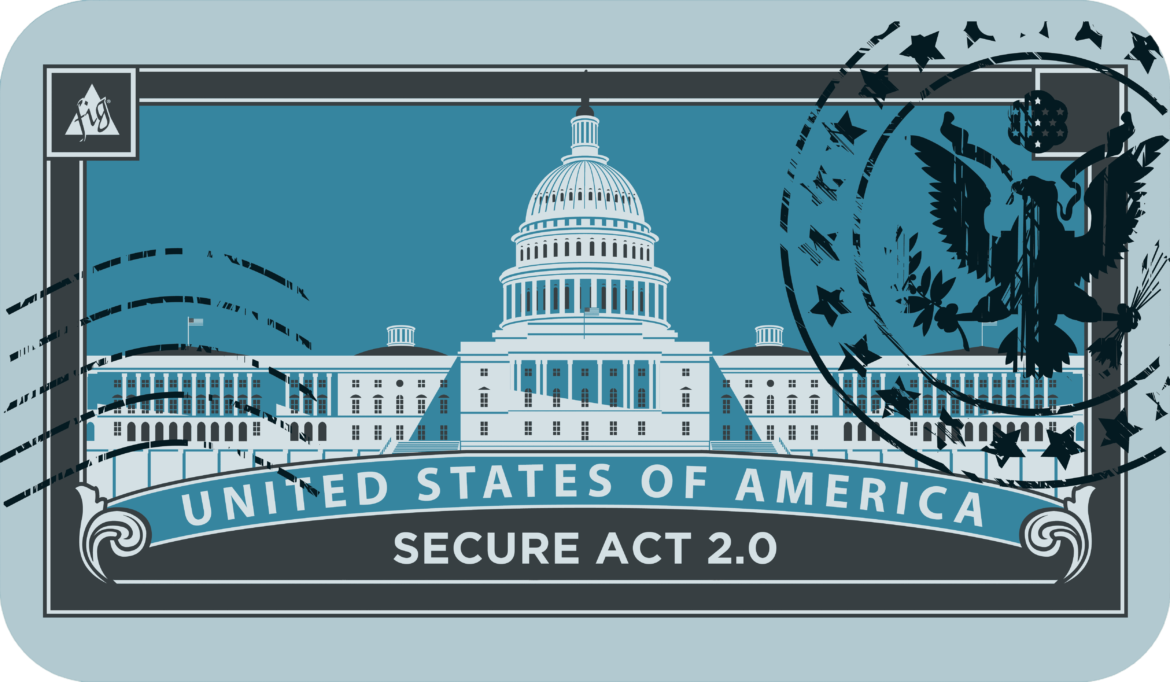President Biden signed the 2023 Omnibus Appropriations package on December 23, 2022.
Included in this funding bill for federal government operations was the SECURE 2.0 Act. The new version of the 2019 SECURE Act has key implications for retirement plans and outcomes.
Here’s a summary of 15 important SECURE 2.0 Act changes that you should know.
New SECURE 2.0 Act Provisions
1. Required Minimum Distribution (RMD) Age Increase
The original SECURE Act increased the RMD age to 72, but the SECURE 2.0 Act goes further. Effective on January 1, 2023, the RMD age increased to age 73, and on January 1, 2033, the RMD age will rise again to age 75. Additionally, the 50% penalty for not taking an RMD will decrease to 25% starting in 2023.
2. Adjusts Lifetime RMDs From Roth Accounts
In 2024, the need for minimum distributions from designed Roth 401(k) accounts will be eliminated. The rule requiring no lifetime RMDs for regular Roth IRAs will remain.
3. Inflation-Adjusted Catch-Up Contribution Limits
The age 50 IRA catch-up provision currently allows for a $1,000 contribution limit for people 50 and over. In 2024 this limit will be indexed to account for inflation, which could increase yearly. This will be based on federally defined cost-of-living increases.
4. Higher Catch-Up Contributions
In 2023, participants aged 50 or older can contribute an extra $7,500 per year into their 401(k) account. Beginning in 2025, this amount increases to the greater of $10,000 or 50% more than the regular catch-up amount in 2024 annually for participants between the ages of 60-63.
Also of note: starting in 2024, all catch-up contributions must be made on an after-tax (Roth) basis if the participant earns more than $145,000 annually.
5. Extended RMD Credit for Annuitized Qualified Accounts
Before the SECURE 2.0 Act, only a portion of a qualified account that’s annuitized for the owner’s life expectancy (or shorter) has been able to satisfy the minimum distribution for the annuitized portion of the account. Now, excess annuitized distributions can count toward the RMD obligation for the rest of the account. The IRS is tasked with providing more guidance and revising regulations to reflect this change.
Related: Asset Location & Tax Management Inside a Portfolio [Ideal Clients, Selling Points, & Case Study]
6. Changes to Qualified Longevity Annuity Contracts (QLACs)
To boost QLACs, the SECURE 2.0 Act increases the qualified plan amounts used to purchase a QLAC to $200,000, up from $145,000. This change is now in effect.
7. Looser Rules on Qualified Charitable Distributions (QCDs)
As part of their QCD limit, people 70 ½ and older can elect a one-time gift up to $50,000, adjusted for inflation each year, to a charitable remainder unitrust, charitable gift annuity, or charitable remainder annuity trust. This new provision expands the type of charity or charities that can receive a QCD. Note that this amount does count toward the annual RMD if applicable. The annual $100,000 QCD limit will also be inflation-indexed.
8. Savings Incentive Match Plan for Employees (SIMPLE) and Simplified Employee Pension (SEP) Plans Now Accept Roth IRA Contributions
Before the SECURE 2.0 Act, SIMPLE and SEP couldn’t accept Roth options, and all contributions were made pre-tax. Starting in 2023, SIMPLEs and SEPs permit account holders to elect a Roth option for employee and employer contributions.
9. Roth Designation for Employer-Offered Portion of 401(k), 403(b), 457(b)
Now in effect, an employee participating in a 401(k), 403(b), or 457(b) plan can elect to have the contributions from their employer credited to the designated Roth portion of the plan.
10. Qualified Account Rollover Without 72(t) Invalidation
Beginning in 2024, the SECURE 2.0 Act will explicitly allow for a complete rollover of a qualified account—without invalidating Section 72(t) life expectancy distributions from said account.
Before the newly enacted provisions, many accountholders used Section 72(t) life-expectancy distributions to help prevent the penalty tax for early distributions. Now, it’s possible to carry out a rollover for an entire account where 72(t) distributions were made.
11. 529 Rollovers to Roth IRAs
After 15 years, 529 account beneficiaries will be allowed to make limited tax-free rollovers starting in 2024. This rule is subject to Roth contributions limits and a cumulative lifetime limit of $35,000. The rollover is also considered a contribution towards the Roth IRA annual contribution limit.
12. Two New Exceptions for Added Tax on Early Distributions
An added 10% tax typically applies to pre-59 ½ distributions from qualified accounts such as 401(k) plans and IRAs. Beginning in 2024, the SECURE 2.0 Act provides new exceptions to the extra tax in the following circumstances:
- Personal or family emergency expenses: For unforeseen or immediate financial needs, one distribution of up to $1,000 is allowed annually. The taxpayer can repay the distribution within three years, but no other emergency distributions are permitted until repayment occurs.
- Victim of domestic abuse: If a participant self-certifies that they’ve experienced domestic abuse, they may withdraw 50% of the participant’s account or $10,000—whichever is smaller. Again, there’s an opportunity to repay the withdrawn money within three years. This change also allows income tax refunds on reciprocated money.
13. Terminally Ill Exception for 10% Tax on Pre-59 ½ Distributions
The SECURE 2.0 Act adds a terminally ill exception for the 10% additional tax on pre-age-59 ½ distributions. A physician must certify that the illness or condition will reasonably result in death in less than seven years (84 months).
14. Distributions for Qualified Long-Term Care (LTC) Coverage
A new exception to the penalty tax for qualified plan distributions will be made to pay for qualified LTC insurance. This exception allows up to $2,500 a year to be used and will begin in 2026.
15. Ability to Find Missing Qualified Funds with “Lost and Found” Database
One more important SECURE 2.0 Act provision to note is the creation of a searchable online database to help people find lost qualified funds by 2025. This database will allow participants or beneficiaries to search for information on administrators of plans in which they may have a benefit.
Related: Tune in to Recent Retirement Inside Out Episodes [Podcast for Financial Advisors]
Final Thoughts on SECURE 2.0 Act Changes
These key provisions of the SECURE 2.0 Act change the retirement planning environment. However, more guidance is needed from lawmakers and regulators, and further analysis is likely necessary.
As a financial professional, it’s essential to understand that the increased RMD age provision will likely be the aspect that affects the majority of your clients. However, some provisions offer new opportunities to engage with business owners, such as the changes to SIMPLE and SEP plans.
Regardless of the reason, the SECURE 2.0 Act welcomes exciting changes to our industry and will give you ample reasons to engage your clients and prospects to help them find the best course of action for their particular needs.
Disclosure: This material was created by Financial Independence Group for use by their partner agents. This material was created to provide accurate and reliable information on the subjects covered. It is not intended to provide specific legal, tax or other professional advice. The services of an appropriate professional should be sought regarding individual situations. Financial Independence Group does not offer legal or tax services. The company providing this document is not affiliated with any government entity or program.
Sources:
1. Linda Sudzius & Jennifer Lollar. SECURE 2.0 Act Enacted as Part of Omnibus Appropriations Package. Advanced Underwriting Consultants Life Live Newsletter, January 2023.
2. “SECURE 2.0 Act of 2022 Makes Sweeping Changes to Retirement Savings Plans.” ADP. January 5, 2023. https://www.adp.com/spark/articles/2023/01/secure-20-act-of-2022-makes-sweeping-changes-to-retirement-savings-plans.aspx
3. “SECURE 2.0: Rethinking retirement savings.” Fidelity. January 3, 2023. https://www.fidelity.com/learning-center/personal-finance/secure-act-2



